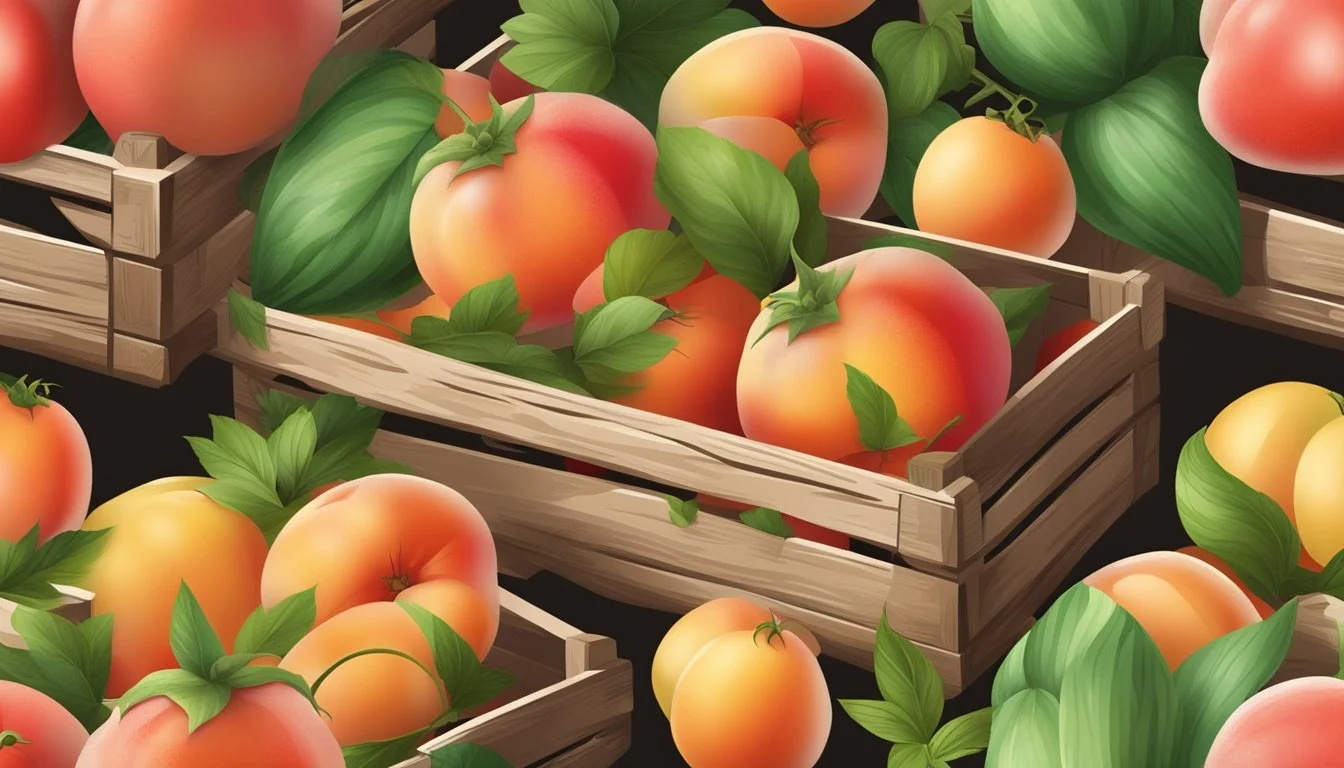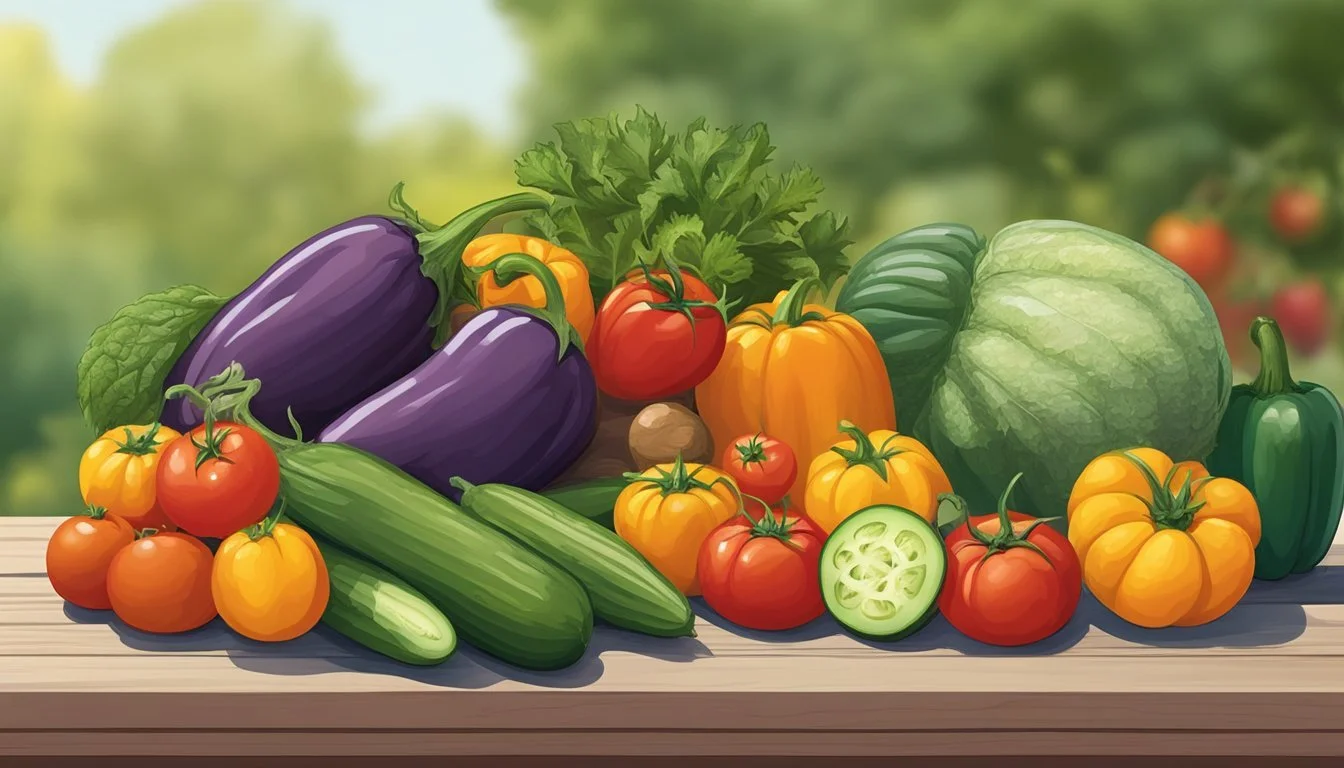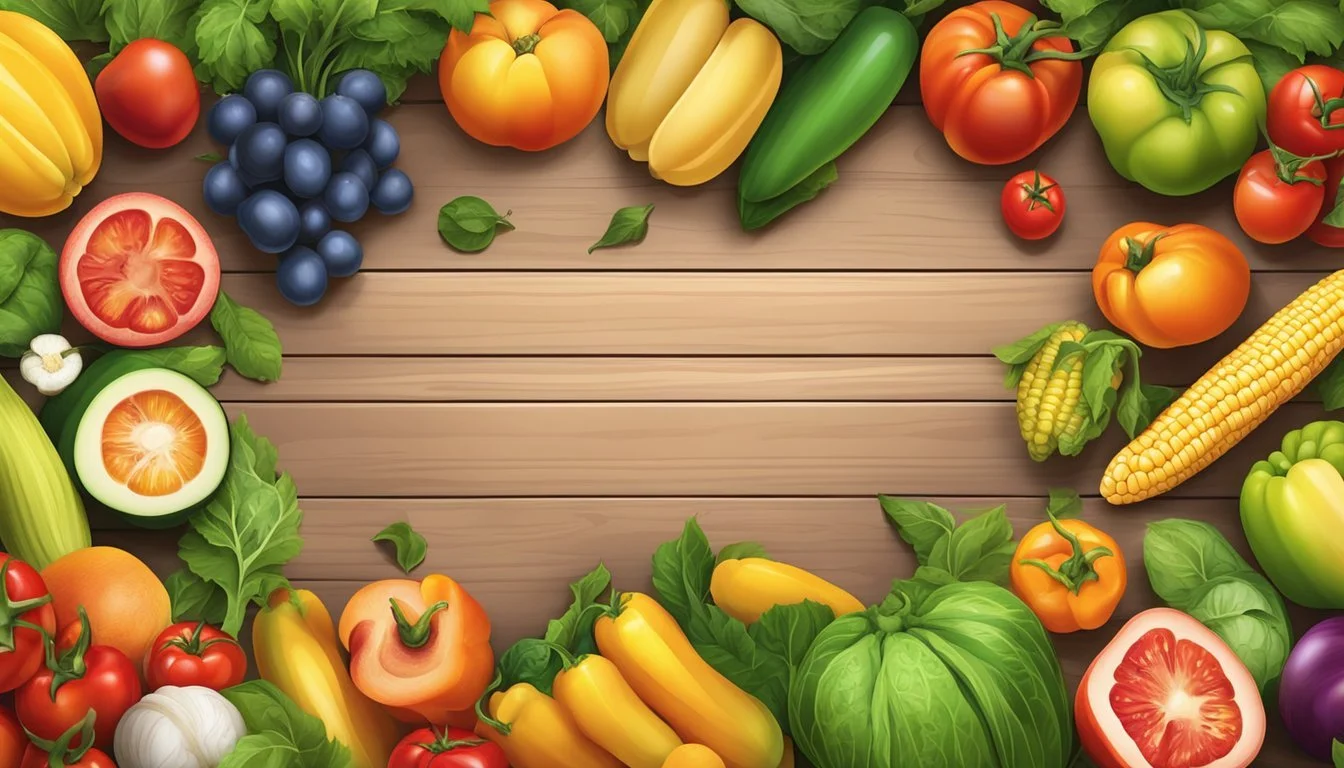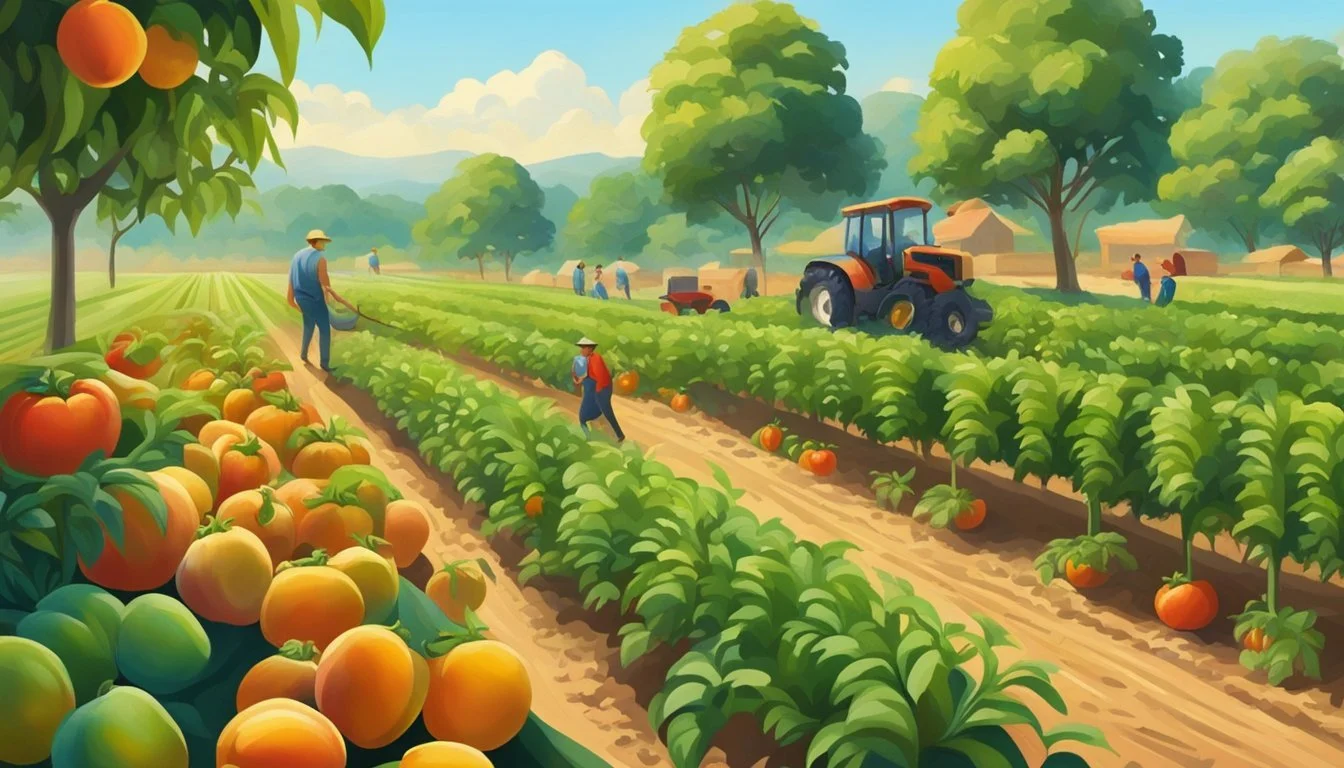South Carolina Seasonal Fruit & Vegetables in September
Your Harvest Guide
This Article is Part of our South Carolina Seasonal Fruit & Veg Calendar
South Carolina's diverse climate creates an ideal environment for growing a rich variety of fruits and vegetables. September marks a vibrant period of harvest in the state, reflecting a unique blend of summer's end and the cusp of autumn's bounty. As the summer heat begins to wane, the agricultural focus shifts to crops that thrive in the milder temperatures and conditions.
During this time, the state's produce offerings are particularly varied. Farmers and gardeners reap the rewards of their labor with a selection of fruits such as the last of the Grimes Golden and Jonagold apples, which reach their peak by late September. Vegetables also take center stage, with an abundance of green beans available from June through September.
With the approach of fall, South Carolina's harvest includes not only beans but also a dynamic array of greens and root vegetables. Kale, known for its improved flavor following a touch of frost, begins its best season, while various squashes come into their prime. The harvest is not just about produce for the table, as decorative gourds and pumpkins also ripen, signaling the arrival of autumn festivities.
Overview of South Carolina Seasonality
In South Carolina, the climate and yearly weather patterns play a pivotal role in determining the availability of fruits and vegetables. September marks the transition into fall, offering a diverse array of produce.
Climate Influences on Produce
South Carolina's climate is classified as humid subtropical. This climate type contributes to a long growing season and supports a wide range of fruits and vegetables. The mild winters and hot summers influence the types of produce that thrive in different parts of the state. Year-round availability of certain crops is made possible by these favorable conditions.
Seasonal Varieties:
Fall: Apples, Pumpkins, Sweet Potatoes (What wine goes well with sweet potatoes?), Winter Squash
Harvest Seasons in South Carolina
The state's harvest seasons can generally be divided into spring, summer, fall, and winter crops. September falls within the fall harvest season, where one begins to see the transition from summer favorites to the heartier fall selections.
Crops Typically Harvested in September:
Fruits: Apples, Muscadines, Pears, Figs
Vegetables: Sweet Potatoes, Squash, Collard Greens (how long do collard greens last?), Cucumbers
These lists showcase that many fruit and vegetable varieties come into season in the fall, while some, like squash and sweet potatoes, reach their peak in September.
Fruits Harvested in September
In September, South Carolina's harvest features a wide range of fruits including the last of the stone fruits and an array of melons, with apple varieties also beginning to peak.
Stone Fruits and Berries
Peaches: September often marks the end of the peach season in South Carolina, with late-ripening varieties being picked.
Figs: This is a key month for figs, which tend to be ripe and ready for harvest.
Peaches, known for their juicy sweetness, are typically winding down, but they can still be found in abundance. Figs, with their unique flavor and texture, present a rich harvest opportunity for those looking to enjoy late-summer fruits.
Melons and Tropical Fruits
Watermelons: Though approaching the season’s end, watermelons are still available and ripe.
Persimmons: September introduces the beginning of persimmon season in South Carolina.
Watermelons are harvested, offering their refreshing taste during the lingering warm days of early autumn. Persimmons, starting to come into season, provide an exotic flavor profile and are becoming increasingly popular in local markets.
Vegetables Available in September
In September, South Carolina's harvest brings a diverse range of vegetables, including a variety of leafy greens, and a mix of root vegetables and gourds that are perfect for the beginning of the fall season.
Leafy Greens and Cruciferous Vegetables
South Carolina's September climate supports the growth of hearty leafy greens and cruciferous vegetables. Residents and chefs alike can enjoy:
Kale: Rich in nutrients and versatile for cooking.
Spinach: A tender and flavorful addition to salads and sautés.
Collard Greens: A Southern staple, collard greens are at their best when they've had a touch of frost.
Cabbage: Crisp and perfect for slaws or cooked dishes.
Roots and Gourds
The root vegetables and gourds available during September are the backbone of savory autumn dishes. Notable mentions include:
Sweet Potatoes: These are beginning their season and bring sweetness to any dish.
Beets and Carrots: Both root vegetables offer vibrant colors and are packed with flavor.
Squash: Including butternut and acorn varieties, squash is a highlight of the season.
Pumpkins: Ideal for both decoration and cooking, pumpkins signal the start of fall.
This month’s harvest also includes other favorites like eggplants (What wine goes well with eggplant?), okra, cucumbers (how long do cucumbers last?), and tomatoes, although these may be winding down as the cooler temperatures arrive. Peppers remain prevalent and add a pop of color and flavor to dishes.
South Carolina Specialty Crops
In South Carolina, September marks a time when the fields are abundant with a variety of specialty crops. Among these, legumes, and pods stand out for their nutritional value, while herbs infuse the state's cuisine with diverse flavors and aromatics.
Legumes and Pods
Beans: Varieties such as snap beans and butter beans are harvested in September. They are versatile for cooking and rich in protein.
Peas: Including sugar snap and English peas, these legumes are picked for their sweet flavor and are excellent in salads or as side dishes.
Sweet Corn: Sweet corn is known for its tender kernels and is a popular choice for grilling or boiling during this month.
Green Beans: These are staple in local dishes, typically found fresh in September.
Peanuts: Although not a bean, peanuts are a significant legume grown in the state, often harvested in the fall.
Herbs and Aromatics
Basil: (how long does basil last?) Aromatic basil is at its peak, perfect for pesto or as a fresh garnish.
Parsnips: While not an herb, parsnips are sometimes included for their flavorful contribution to autumn dishes.
Herbs: This category covers a range of locally grown herbs such as cilantro (how long does cilantro last?) and parsley, essentials in culinary use for their fresh, vibrant flavors.
Selecting and Storing Produce
When selecting and storing produce, one should look for certain ripeness indicators and employ specific preservation techniques to maintain freshness and flavor.
Optimal Ripeness Indicators
Apples: Look for firm, vibrant, and unbruised apples. A ripe apple will be sweet and slightly tender, having a crisp bite. For tart varieties like Granny Smith, a bright green color is an indicator of ripeness.
Peppers: Fresh ripe peppers should have glossy, unblemished skin. They are best when firm to the touch, indicating they are at peak ripeness for raw consumption or cooking.
Winter Squash: Select squash with dull, hard skins without any soft spots. They should feel heavy for their size, a sign that they are not only ripe but also full of moisture.
Preservation Techniques
Freezing: To preserve fruit such as apples, one can peel, core, and slice them before freezing. By drizzling with a bit of lemon juice, one can prevent browning. Cut produce should be spread on a baking sheet to freeze individually before transferring to airtight containers.
Vegetables: Bell peppers (What wine goes well with bell peppers?) can be stored in the refrigerator, where they will maintain their crispness. However, for long-term storage, one can slice peppers and freeze them raw. Vegetables like winter squash should be stored in a cool, dark place with good ventilation and can last for months.
By following these straightforward indicators and techniques, fresh produce from South Carolina's September harvest can be enjoyed at its best quality.
Preparing Seasonal Dishes
September in South Carolina ushers in a bountiful harvest that can transform your cooking. The focus on sweet corn, peaches, tomatoes, eggplant (What wine goes well with eggplant?), and greens allows for a rich tapestry of flavors, with dishes ranging from the traditional comforts of Southern cooking to innovative culinary twists.
Traditional South Carolina Recipes
Sweet Corn and Tomato Salad
Ingredients: Fresh sweet corn, ripe tomatoes, basil leaves, red onion, olive oil, cider vinegar, salt, and pepper.
Method: Combine cooked corn kernels and chopped tomatoes with thinly sliced red onion and torn basil. Dress with olive oil and cider vinegar, then season to taste.
Stewed Eggplant and Tomatoes
Ingredients: Eggplant, tomatoes, onion, garlic, olive oil, and seasonings.
Method: Cube and salt the eggplant, then sauté with diced onions (What wine goes well with onions?) and minced garlic until golden. Add tomatoes and simmer until the mixture is tender and flavorful.
Peach Cobbler
Ingredients: Fresh peaches, flour, sugar, butter, milk, and baking powder.
Method: Layer sliced peaches with sugar in a baking dish. Cover with a batter made from flour, sugar, melted butter, milk, and baking powder. Bake until golden and bubbly.
Collard Greens with Smoked Turkey
Ingredients: Collard greens, smoked turkey, onion, garlic, chicken stock, and apple cider vinegar.
Method: Sauté onion and garlic, add the smoked turkey, and then the collard greens. Pour in chicken stock and simmer until the greens are tender, finishing with a splash of apple cider vinegar.
Innovative Culinary Ideas
Grilled Peach and Sweet Corn Salsa
Ingredients: Grilled peaches, sweet corn, red onion, jalapeño, cilantro, lime juice, salt, and pepper.
Method: Chop grilled peaches and combine with cooked corn kernels, diced red onion, minced jalapeño, chopped cilantro, lime juice, salt, and pepper for a fresh salsa twist.
Eggplant 'Bacon'
Ingredients: Eggplant, soy sauce (how long does soy sauce last?), maple syrup (how long does maple syrup last?), smoked paprika, and garlic powder.
Method: Slice the eggplant thinly, marinate in a mixture of soy sauce, maple syrup, smoked paprika, and garlic powder, then bake or dehydrate until crispy.
Raw Tomato Gazpacho
Ingredients: Ripe tomatoes, cucumber, bell pepper, red onion, garlic, olive oil, sherry vinegar, and seasonings.
Method: Blend raw tomatoes, cucumber, bell pepper, red onion, and garlic until smooth. Season with olive oil, sherry vinegar, salt, and pepper, then chill before serving.
By integrating South Carolina’s seasonal produce into these dishes, both traditional and innovative, one can create flavorful meals that encapsulate the essence of September’s harvest.
Farmers Markets and Local Economy
In South Carolina, farmers markets are a vital component of the local economy, connecting consumers with fresh, seasonal produce and supporting regional agricultural businesses.
Benefits of Buying Local Produce
Economic Impact: Buying local produce at South Carolina farmers markets sustains the local economy by circulating funds within the community. It bolsters the livelihoods of local farmers, allowing them to continue their operations and contribute to the economic stability of the region.
Freshness and Quality: Local produce is renowned for its freshness and high quality. When consumers purchase vegetables and fruits from area markets, they typically receive produce that has been harvested at its peak ripeness, ensuring maximum flavor and nutritional value.
Local Market Offerings
Seasonal Availability: During September, South Carolina’s markets overflow with a diverse range of produce. Customers can expect to find items such as:
Vegetables: Okra, Peppers, Tomatoes, Sweet Potatoes
Fruits: Apples, Muscadines, Figs, Pears
Market Schedule and Locations: Many South Carolina farmers markets operate under seasonal schedules, some extending into the fall. Weekly markets allow for consistent access to local produce, managing to serve as community hubs for the exchange of goods and fostering an environment where local economies thrive.
Agricultural Challenges and Sustainability
In South Carolina, agricultural productivity faces challenges nonetheless benefits from sustainability efforts, particularly in September when there's a seasonal shift. The impact of climate change is evident, while sustainable farming practices are seen as vital responses to these challenges.
Impact of Climate Change
Climate change affects seasonal cycles, with fluctuating temperatures and irregular rainfall patterns impacting the growth of fruits and vegetables. September can experience shifts in weather that threaten crop yields and stress water resources. For instance, there may be unseasonal heat waves that hasten fruit ripening, potentially reducing their marketable shelf life.
Sustainable Farming Practices
Farmers in South Carolina have adopted various sustainable farming practices to mitigate these challenges. Key practices include:
Crop Rotation: Introducing a diverse range of crops to improve soil health and reduce pest cycles.
Cover Crops: Utilizing cover crops to enhance soil structure, add nutrients, and prevent erosion.
Conservation Tillage: Minimizing tillage to maintain organic soil matter and reduce erosion.
Integrated Pest Management (IPM): Combining biological, cultural, physical, and chemical tools to manage pests sustainably.
Efficient Water Use: Implementing drip irrigation and other water-efficient systems to maximize water usage and reduce waste.
Conclusion
In September, South Carolina's mild climate and fertile soils deliver an abundance of fresh produce. It is crucial for consumers to consult a seasonal guide to make informed choices. They can enjoy a myriad of fruits and vegetables that are at their peak of freshness and nutritional value.
The following table illustrates common September produce in South Carolina:
Fruits Vegetables Apples Butternut Squash Muscadines Spaghetti Squash Pears Pumpkins Figs Sweet Potatoes
This assortment allows for a comprehensive knowledge of what is locally available, ensuring that the residents and visitors of South Carolina have access to produce that likely has higher nutritional content and flavor. They support local economies and sustainable practices by favoring seasonal produce.
South Carolina’s September harvest also includes a selection of leafy greens and a variety of squash, marking the transition from summer to fall with a shift in flavors and culinary opportunities. It presents a perfect chance for exploring heartier recipes and enjoying the state's agricultural bounty. For those interested in seasonal eating, embracing the local harvest can lead to delightful gastronomic discoveries and a deeper appreciation for the state's agricultural rhythm.










